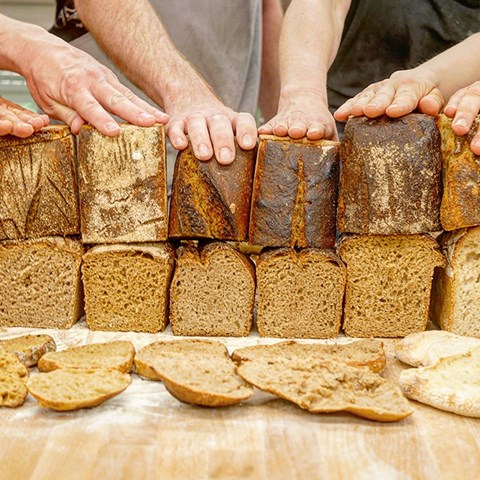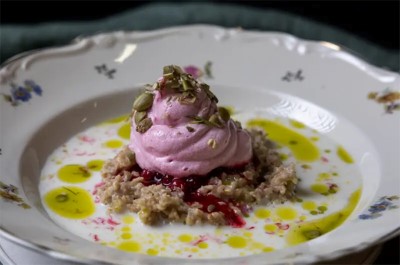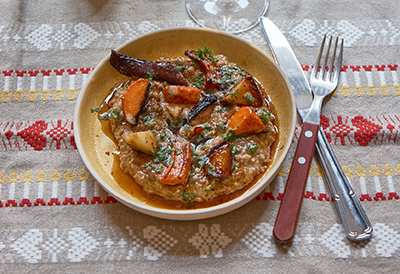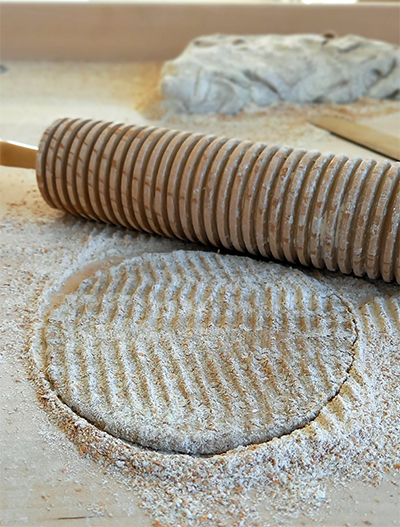Contact
Department of Urban and Rural Development, Division of Political Science and Natural Resource Governance

Porrage, soft bread, hard bread - heritage cereals can be used for breakfast, lunch, dinner and snacks. It can be eaten as a simple meal with milk, or you can use all uour skill making a fancy dinner. Here are some ideas and inspiration for using heritage cereals.
Try our recipes with heritage cereals! There are both simple straight forward recipes, and some a bit more complex - when you feel like a challenge. Click the headings below for the recipes. If you don´t have access to the cereal varieties in the recipes, you can use spelt or other local land varieties instead.

Serves 4–6
Day 1
Day 2
Steps:
Day 1
1| Place the crushed cereals, seeds, dried fruit and salt in a container with a lid and pour the water over it. Stir a bit, cover and refrigerate overnight.
Day 2
2| Pour the soaked porridge mix in a large saucepan with a lid and add the apple juice. Stir with a heat-resistant spatula (or wooden sauté paddle) and turn on the heat. Stir. When the porridge starts to thicken and steam, turn off the heat and put the lid on.
3| Cut the apple or pear into small pieces and add to the porridge. Add the frozen berries and half of the crushed nuts. Stir, sweeten to taste, sprinkle with the rest of the nuts and drizzle a bit of honey on top. Pour some milk on and serve.
A recipe from the Swedish championship in eco-porridge, 3rd place by Jeffrey Bickford: a breakfast porridge with berries.
4 servings
Porridge, day 1
Day 2
Steps:
Day 1
Measure the coarsely ground grains and soak in water overnight.
Day 2
Cook the porridge over a low heat for about 35 minutes or until soft. Salt to taste.
Serve with uncooked lingonberry jam or other berries, forest honey and maple syrup. Sprinkle a small amount of sea buckthorn powder on top and pour milk on the porridge at serving.

Serves 4-6
Day 1
Day 2 (or 3–4 days later)
Day 1
1| Place the crushed cereal and salt in a covered container and place in the refrigerator to swell.
Day 2
2| Cut the carrots into smaller pieces and place on a baking sheet, drizzle olive oil over them, salt and pepper to taste. Roast in the oven at 200°C for 10–12 minutes.
3| Pour the soaked porridge mix in a large saucepan with a lid and add the crushed tomatoes, juice or stock and minced onion. Bring to the boil and simmer for a while, stirring from time to time and watching carefully that it doesn’t stick to the bottom of the pan. When the porridge starts to thicken and steam, add the wine and stir.
4| Taste and stir until you are satisfied with the consistency, then mix in the roasted carrots. Cover and leave to stand.
5| In a separate saucepan, brown the butter, stirring the whole time so it does not stick to the pan.

This recipe by Sebastién Boudet uses sifted Öland wheat (a local variety from the island of Öland outside Swedens southeast coast). It takes two days, and you can vary the rising time to achieve the desired flavour and appearance.
Makes 1 large loaf.
Ingredients:
Steps:
Day 1:
Mix the water, salt, sourdough and half the flour in a bowl into an even batter. Add the rest of the flour and work it in by hand. Scrape down any dough that sticks to the side of the bowl with a pastry scraper and cover the bowl with a damp kitchen towel. Let stand at room temperature for 1–2 hours. (During this time, the dough will start forming gluten. You do not have to do anything.)
Fill a bowl with cold water. Dip the pastry scraper in the water and slide it around the edge of the mixing bowl to loosen the dough. Then wet your hands, pull the dough up from the edges of the bowl and fold it in towards the middle. Turn the bowl and repeat this step. Keep doing this until the surface of the dough feels taut. If you notice that the dough starts to crack when you pull on it, then it needs to rest a while before you continue.
Place a floured kitchen towel in a proofing basket and place the dough in the middle of the basket. Pull the dough from the edges towards the middle one last time, then wrap it in the floured towel. Let stand at room temperature until it starts rising and increases somewhat in size.
Place the basket in a box with a lid that seals tightly. Put it in the refrigerator to rise, anywhere from 12–70 hours. The length of time is a matter of taste and appearance; the longer it rises, the fluffier and more flavourful it becomes.
Day 2:
Time to bake the bread! Place a cast-iron casserole in the oven and heat the oven to 250 C with top and bottom heat. Cut a baking sheet into a round shape. Flour the top of the dough (which will soon be the bottom), then turn it out onto the baking sheet. Carefully shape the loaf with your hands and slice the surface with a sharp knife or razor blade. Use the baking sheet to carry the loaf over to the hot casserole.
Put the lid on the casserole and bake the bread in the centre of the oven for 45–55 minutes, with the lid on the whole time. Check that the bread is cooked all the way through. If not, bake without the lid for another 10–20 minutes, depending on how well-done you want the bread and how thick a crust you want.
Take the bread out of the casserole and place on a cooling rack. NOTE: Never slice hot bread! If you cut into hot bread, it will ‘bleed’ fluid that has not had time to condense. When bread is allowed to rest and slowly cool down it will keep longer and have a better flavour and a nicer crust. The bread will keep for several days wrapped in a kitchen towel or a cloth/beeswax bag.
A flatbread recipe by Anki Berg, Ångermanland Province, with Midsummer rye and Dalarna wheat.
Flatbread can be soft or crisp, and comes in many varieties depending on the choice of grain. Usually made from some combination of wheat, barley and/or rye flour, flatbread is traditionally baked briefly in a hot, wood-fired oven.
I make both crisp and soft flatbread from this dough. I roll it out to about 40–45 cm in diameter. One litre of water gives me about 13–14 pieces of bread.
Ingredients:
Steps:
In the evening before baking, or at least six hours before baking:
Boil one litre of water and pour it over 400 g of Midsummer rye. If you want spices in the bread, add them now. I usually add one bag (about 14 g) of bread spices per litre of water. Cover with plastic wrap or a lid and let stand at room temperature.
In the morning, or when fine little sourdough bubbles have formed and the bread starter looks lively, add:
If you use milk, you can skip the cream and use milk for both quantities – 2.2 litres total.
Combine into a firm dough. Add more flour if it feels too soft. Let the dough rise for at least two hours at room temperature. You can also let the dough rise for up to five hours, but in this case in a cool temperature. Shape into small balls and roll out into thin wafers, 1-2 mm thin. In a wood fired baking oven (300-400 degrees C), bake for 30 sec-1 min. If you use a normal electric oven, bake at max temperature (250 degrees C or more) for around 2 min. Use shorter time if you want the bread to be a bit soft. Be sure to watch the bread as it bakes in the oven, to prevent it from burning. Place on cooling racks to cool.